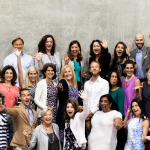Search
Results for: "design thinking "
Course
Giving Tuesdays for #GivingTuesday: Using Design Thinking to Catalyze Activism and Philanthropy
Apply design thinking to the domains of activism and philanthropy. Learn about core design principles and explore how these principles are relevant not to the design of a material product but to the activation of a social movement. After Black Friday and Cyber Monday, cultural events to mark massive consumerism, #GivingTuesday is a movement...
Article
Design Thinking and Strategic Philanthropy Case Study (August 2015)
Using human centered design for a greater philanthropic impact. This is a case study of how human centered design (HCD), also called design thinking, can be integrated with strategic planning to help philanthropists achieve greater impact. HCD, initially developed in the context of consumer products and services, is in the...
Video
Informing Your Philanthropy: The Nexus of Design Thinking and Strategic Philanthropy
Stanford PACS Philanthropy Innovation Summit 2015 – Informing your Giving. The Nexus of Design Thinking and Strategic Philanthropy
Philanthropy and Design Thinking
Philanthropy and Design Thinking (Paul Brest and Nadia Roumani)
Event
Design Strategies for Impactful Storytelling: From Data to Dialogue
Our world is data-rich — big data, small data, limp data, qualitative, quantitative, and mixed data. Like clay, data is a medium available for shaping stories. When we create maps and infographics, we do so at the confluence of data and design. Skillfully navigating and crafting impactful visual stories is an...
Event
Design Strategies for Impactful Storytelling: From Data to Dialogue
Presented by Carissa Carter, Academic Director, Stanford d.School (the Hasso Plattner Institute for Design at Stanford University) Moderated by Aaron Bady Our world is data-rich — big data, small data, limp data, qualitative, quantitative, and mixed data. Like clay, data is a medium available for shaping stories. When we create maps and...
About
What We Do We are an interdisciplinary team working at the intersection of strategic philanthropy, the behavioral sciences, and design thinking to accelerate learning for donors and relevant support staff, advisors and other intermediaries in the donor-support ecosystem—so they can make more informed and deliberate giving decisions, thereby increasing their...
Effective Philanthropy Learning Initiative
Our Mission The Effective Philanthropy Learning Initiative (EPLI) at Stanford PACS conducts research, develops resources, and delivers educational programs to help donors worldwide become more effective, catalytic philanthropists. We are an interdisciplinary team working at the intersection of philanthropy, the social sciences, and design thinking to accelerate learning for donors...
Philanthropy Innovation Summit 2015 Learnings
In alignment with our mission to improve philanthropy, strengthen civil society, and create positive social change, the 2015 Summit brought to light strategies and experiences of influential philanthropists with the aim of inspiring and guiding their peers and in turn, philanthropists all around the world. In 2015, speakers covered topics...
Course
Give Big or Go Home
When individuals or organizations attempt to solve social problems by giving money, they often overlook the people at the center of the situation. The bigger the problem, the more removed the donors or funding institutions become from the human experience. You will learn how to use human centered design to...
Course
Give Big Or Go Home
When individuals or organizations attempt to solve social problems by giving money, they often overlook the people at the center of the situation. The bigger the problem, the more removed the donors or funding institutions become from the human experience. You will learn how to use human centered design to...
Stakeholder Engagement & Education
Sharing our learnings As an academic initiative based at Stanford PACS, EPLI is uniquely situated to leverage its convening power to shape a community of practice focused on increasing outcome-focused philanthropy — a “network of networks” for philanthropic giving composed of donors, donor education groups, nonprofits and other key stakeholders....





